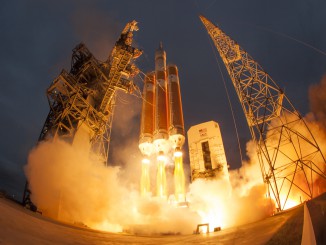
CAPE CANAVERAL — The final year of launches in the current breed of Global Positioning System navigation satellites kicks off Wednesday afternoon aboard a Delta 4 rocket from Cape Canaveral.
GPS 2F-9 is slated for liftoff during a window of 2:36 to 2:54 p.m. EDT and will follow a flight azimuth of 46 degrees, heading up the Eastern Seaboard.
Weather forecasters are predicting an 80 percent chance of favorable conditions at launch time.
This launch will be “adding capability to the most widely recognized satellite constellation in the world,” said Col. Kent Nickle, GPS 2F-9 mission director.
Four GPS launches over the next 10 months, through next January, will complete the deployment of Boeing-built Block 2F spacecraft that feature improved accuracy, additional signals, enhanced anti-jamming and longer design lives.
“This past year, the GPS 2F team launched, tested and put into service four spacecraft — the fastest GPS mission in over 21 years. And (Wednesday) we will launch the ninth GPS 2F satellite onboard a Delta 4 launch vehicle, and we stand ready for a successful launch,” said Brig. Gen. Bill Cooley, director of the Space and Missile Systems Center’s Global Positioning System Directorate
The Delta 4 rocket will fly in its Medium+ 4,2 configuration with a four-meter nose cone and two strap-on boosters. The upper stage will complete two burns to deliver the payload directly into the navigation network.
The rest of the upcoming GPS 2F satellites will fly aboard ULA Atlas 5 rockets, with launches targeted for June 16, Sept. 16 and Jan. 26. The first GPS Block 3 spacecraft — representing the next modernization step — is scheduled for 2017.
“A path forward is in work to modernize GPS, and the 2F capability plays a vital role updating the GPS constellation and maintaining the high-level of accuracy required by the GPS system,” Cooley said.
The $245 million GPS 2F-9 satellite will join the orbiting constellation as the 31st functioning spacecraft with 7 backups, according to Cooley.

It will take three hours and 14 minutes from launch until spacecraft separation, delivering the satellite into an orbit 11,000 nautical miles high and tilted 55 degrees to the equator.
GPS 2F-9 will take Plane B, Slot 1F of the network in a shuffling plan that ultimately enhances the network. It should be checked out and operational in April.
“Every time we get into launch, there’s a discussion of which Plane are we going to launch this in to and which satellite we want to retire,” Cooley said.
This satellite will take the place of GPS 2A-22 or SVN-35, launched aboard Delta 222 in August 1993, and now will be permanently retired.
“Space Vehicle Number (SVN) 35 is being replaced,” an Air Force sspokesperson said. “Launching the new GPS 2F satellites increases GPS signal capabilities, increases user accuracy with more accurate space atomic clocks, and reduces overall constellation risk.”
It is the year’s second national security space launch, following the Navy’s MUOS No. 3 communications satellite deployed by an Atlas 5 rocket on Jan. 20. Eight more NSS launches are planned through the rest of this calendar year.
“The frequency of these launches may seem routine, but there’s a significant amount of effort that occurs leading up to the day of launch,” said Nickle. “The effective rate at which we launch these missions is made possible by the effective partnership with our provider, United Launch Alliance.”
The launch will be the 371st for a Delta rocket since 1960, the 29th Delta 4 vehicle and the 24th dedicated to service to the Air Force. It also marks the 69th GPS satellite launch, the 55th to use a Delta rocket and the sixth Block 2F on Delta. For United Launch Alliance, it will be the company’s 95th launch overall since 2006 and the fourth of 13 this year.
“Next time you see a rocket launch, you witness that beautiful bird, the roar of sound, the splash of flame, and you see tat thing rise into the sky on a fountain of fire to impossible speeds I’d like ot ask you to just think for a moment that a rocket is an incredible, complex, powerful, unforgiving machine,” said ULA CEO Tory Bruno.
“And every time we go to space, it is an act of defiance. Mother Nature does not like us to leave the nest. She makes it very, very hard. I will tell you it takes very special people to do this work every day, safely and reliably.”
Coming off the pad on the power of the main engine and twin solid rockets, the Delta 4 will be 206 feet tall and generating 1.1 million pounds of thrust.
The vehicle will hit Mach 1 in 48 seconds and surpass the region of maximum air pressure at 61 seconds.
The Orbital ATK solids burn out at 95 seconds and jettison five seconds later, leaving the Aerojet Rocketdyne RS-68 engine, hydrogen-fueled core stage to continue headed to space. Main engine cutoff occurs at 4 minutes, 8 seconds and staging some 7 seconds later.
The upper stage and its Aerojet Rocketdyne RL10B-2 engine then comes to life four-and-a-half minutes into flight and the 13-foot diameter, 39-foot-long composite nose cone enclosing the satellite payload is separated 10 seconds into the burn.
That first burn will last 11 minutes, injecting the rocket into a preliminary, egg-shaped orbit where it will coast for nearly three hours.
A second burn lasting less than two minutes will circularize the orbit and reach the GPS navigation network 11,000 nautical miles in altitude.
Separation of the GPS 2F-9 satellite to complete the launch sequence happens at T+plus 3 hours and 14 minutes, or 5:50 p.m. EDT given an on-time liftoff.
See our earlier GPS 2F-9 coverage.
And see our Delta archive for further information.




